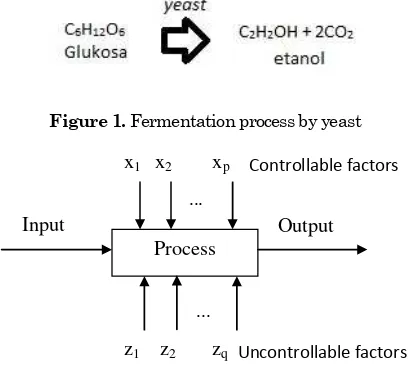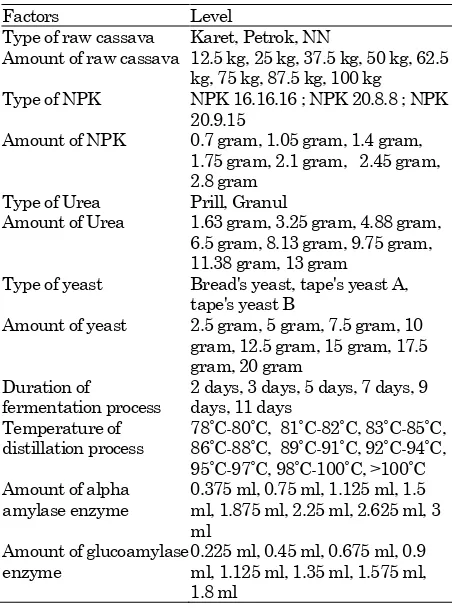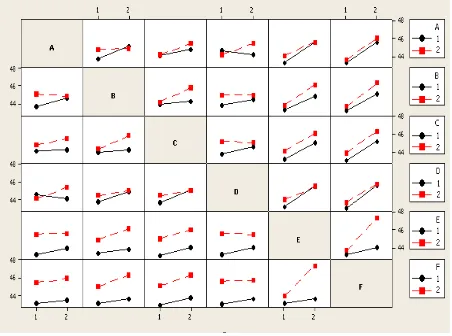Debora Anne Y. A., Togar W. S. Panjaitan, Christianto Wibowo Industrial Engineering Department, Petra Christian University
Jl. Siwalankerto 121-131 Surabaya, Indonesia Email: [email protected], [email protected]
Abstract: The reduction of oil energy reserve makes fuel increased in price. Therefore, alternative energy as a substitute to save fuel is needed. One of the alternative energy is bio fuel, and one of the bio fuel types is bio ethanol. The purpose of this research is to determine the best factors and level combination on bio ethanol fermentation process, in order to made bio ethanol with higher content. Cassava is used as the raw material of bio ethanol making process. This research was conducted using Two Levels Full Factorial Design method. Factors which are studied are the amount of urea fertilizer NPK (fertilizer) type, the amount of NPK, the amount of yeast, the amount of alpha amylase enzyme, and the amount of glucoamylase enzyme. Data was analyzed using ANOVA test, main effect plot, and interaction effect plot. As a result, type of NPK, amount of NPK, amount of alpha amylase enzyme, and amount of glucoamylase enzyme are factors that have a significant effect on the bio ethanol fermentation process. The best combination for this experiment is the amount of urea: 4.88 grams, type of NPK: 20/9/15, the amount of NPK: 1.4 gram, the amount of yeast 10 grams, the amount of alpha-amylase enzyme: 1.5 milliliter, and the amount of glucoamylase enzyme: 1.35 milliliter.
Keywords: Bio ethanol, fermentation, NPK, two levels full factorial design.
Introduction
Nowadays, the fuel consumption keep increasing, therefore there is reduction in oil energy reserve. It is because oil energy reproduction cannot be done in a short period of time. An alternative energy as a sub-stitute to save fuel is needed. One of the alternative energy is bio fuel, and one of the bio fuel types is bio ethanol.
Ethanol (C2H6O) is a volatile, colorless and flam-mable solvent. It is mostly used as a solvent in phar-maceutical industry and in the food and beverage industry. Besides that, ethanol can be used as a car fuel (E 100 for a car with specific engine), or as a ga-soline additive. There are two types of ethanol, which are synthetic ethanol and bio ethanol. The synthetic ethanol is produced from chemical synthesis of petroleum, while the bio ethanol is produced from enzyme fermentation in the biology process. Bio ethanol with 10% until 100% content can be pro-cessed into vehicle fuel, kerosene substitute, cosmetic ingredients, medicinal materials, paint solvents, car-bolic material, and a mixture for alcoholic beverages. Bio ethanol processing can be said to be zero waste because all of the waste can be recycled into fertilizer and animal feed. Bio ethanol also can be an al-ternative to save the fuel. As we now, the octane number of premium is only about 87-88. The octane number of gasohol E-10 (a mixture of 90% premium and 10% bio ethanol with minimum 99.6% content)
is 92. It is almost equal to the octane number of pertamax, which are 95. Bio ethanol is more environ-mentally friendly because it can reduce hydrocarbon emissions in vehicles and not harmful to breathe because it not contain lead (Pb).
There are several factors thought to affect the fermentation process which is producing bio ethanol with higher content. They are quantity and type of the raw material, quantity of water, enzyme, yeast and fertilizer; duration of fermentation process, and etc. The purpose of this research is to determine the best factors and level combination on bio ethanol fer-mentation process, in order to made bio ethanol with higher content bu using Two Levels Full Factorial Design methods were used to find the best combina-tion.
Methods
Process x1 x2 xp
z1 z2 zq
Input Output
...
...
Controllable factors
Uncontrollable factors easily obtained. Microorganism is one of influential
factors in the fermentation process of bio ethanol, because of its function as a biocatalyst. There are two types of microorganism which are usually used in the fermentation process, they are yeast and bacte-ria. Yeast is more commonly used in the fermen-tation process, because it is easier to propagate, easi-er to control growth and can produce high concen-trations of ethanol. There are several types of yeast which can be used in the fermentation process; they are Schizosaccharomyces cerevisiae, Chlamidomucor oryzae, cendawan Aspergillus sp (Klein and Vorlop, [2]). Fermentation is a microbiology process which can be controlled by human, for obtaining a worth-while product. The carbohydrates and amino acids are breakdown into a simple structure, with the help of microorganism, in order to produce energy (Perry, [6]). Fermentation process changes the glucose into alcohol (bio ethanol), with 8% until 10% content. The chemical reaction of fermentation by yeast (s acharo-myces cereviseae), which is produced ethanol and CO2 can be seen at Figure 1.
There are several factors that influence fermentation process:
1. Acidity (pH) 2. Microbe 3. Temperature
Yeast will work optimally at temperature of 10°C-30°C (Winarno [7]). This research use
temperature of 20˚C - 25˚C in the fermentation
process.
4. Length of fermentation
The propagation rate of bacteria varies accord-ing to the species and growth condition. In optimal condition, they propagate once every 20 minutes.
5. Nutrition
Nutrition which are usually use are urea and NPK. (Rama P. et al. [6]).
Distillation device that will be used to purify the bio ethanol is design and made from drum, coppers pi-pes and hoses, with 40 liter capacity.
The second stage is designing and doing the experi-ment. Experiment is a test or series of tests in which purposeful changes are made to the input variables of a process or system so that we may observe and identify the reasons for changes that may be obser-ved in the output response (Montgomery [3]). The general model of a process or system can be seen at Figure 2.
The application of experimental design techniques early in process development can result in improved process yields, reduced variability, reduced develop-ment time, and reduced overall cost (Montgomery [4]). There are three basic principles
Figure 1. Fermentation process by yeast
Figure 2. General model of a process or system
of experimental design; they are randomization, replication and blocking. Pre experiment is needed to be done before the main experiment, in order to determine the factors and levels that will be used in the main experiment. An initial condition is chosen as a comparison for the experiment result. The main experiment in this research was conducted using Two Levels Full Factorial Design method. Factorial designs are widely used in experiments involving several factors, where it is necessary to study the joint effect of the factors on a response. Two Levels Full Factorial Design is a special case of factorial design, where that of k factors, each at is only have two levels. These levels may be quantitative or they may be qualitative. The two levels is symbolized as high level (+) and low level (-). Bio ethanol’s content is the response of this experiment, which is mea-sured by using alcohol meter.
The third stage is analyzing the response which is resulted from the main experiment. Analysis of Va-riance (ANOVA) test, main effect plot, and inter-action effect plot are used as tools for analyzing the data. ANOVA test is used to find whether a factor or interaction among factors influence the response significantly or not, at 5% level of significance. The hypothesis is:
H0: Factor i does not significantly affect the response H1: Factor i significantly affect the response
Results and Discussion
Initial Condition
The initial condition which is used for a standard is taken from Agro Makmur bio ethanol course at Central of Java; which is 50 kilogram cassava, 50 liter water, 1.5 milliliter alpha amylase enzyme, 0.9 milliliter glucoamylase enzyme, 100 gram yeast, 65 gram urea, 14 gram NPK, 72 hours fermentation time, acidity level (pH) more than 1, and distillation temperature is 79°C. The bio ethanol content which is resulted from the initial condition is about 40 %.
Pre Experiment
Refers to the general model of a process or system, the main input of this experiment is raw cassava. There are three main processes for making the bio ethanol, which are mixing, fermentation and distil-lation process. The outputs of this experiment are bio ethanol and wastes which are resulted from fermen-tation and distillation processes. The wastes can be used as animal feed and fertilizer. There are several controllable factors which are thought to affect the response; they are type and amount of raw cassava, type and amount of fertilizer (NPK and urea), type and amount of yeast, amount of alpha amylase enzyme, amount of glucoamylase enzyme, duration of fermentation process, and temperature of distil-lation process. The environment temperature and acidity are uncontrollable factor because they are affected by weather and climate. These factors are determined based on literature study and interview with an expert. Factors and levels which are use in the pre experiment can be seen at Table 1.
The objective of pre experiment is to find the factors and levels which are used in the main experiment, in order to reduce the unnecessary factors.
Experiment
Factors and levels which are use in the main experiment are determined based on the pre expe-riment result (Table 2).
Two-level Full Factorial Design method was used to do the experiment, with two times replication. Total-ly there are one hundred and twenty eight numbers of run. Room temperature is used as fermentation temperature. Bio ethanol’s content is the response of this experiment, which is measured by using alcohol meter. The experiment result can be seen at Table 3.
ANOVA test is used to find whether a factor or interaction among factors influence the response sig-nificantly or not, at 5% level of significance. The output from Minitab 15 can be seen in Table 4.
Table 1. Factors and levels for pre experiment
Factors Level
Type of Urea Prill, Granul
Amount of Urea 1.63 gram, 3.25 gram, 4.88 gram,
6.5 gram, 8.13 gram, 9.75 gram, 11.38 gram, 13 gram
Type of yeast Bread's yeast, tape's yeast A,
tape's yeast B
Table 2. Factors and levels for experiment
Factors Levels
amylase enzyme (E) 1,125 mililiter 1,5 mililiter
Amount of glucoamylase enzyme (F)
1,125 mililiter 1,35 mililiter
It can be shown that factor type of NPK, amount of NPK, amount of alpha amylase enzyme and amount of glucoamylase enzyme significantly affect the bio ethanol content with 5% level of significant. Other-wise, amount of urea and amount of yeast do not sig-nificantly affect the bio ethanol content. Beside the main effect, there are some interactions (2-way inter-action, 3-way interaction and 4-way interaction) that are significantly affect the bio ethanol content with 5% level of significant. Meanwhile both of 5-way in-teraction and 6-way inin-teraction do not significantly affect the bio ethanol content. The regression model of the experiment can be written as follow:
The main effect plot and 2-way interaction effect plot can be seen at Figure 3 and Figure 4.
The response characteristic is higher the better, therefore from the main effect plot it can be seen that level 2 (level +) is better than level 1 (level -) for the Significant factor B, C, E, and F. Meanwhile for factor A and D, it can bee seen that the change in the level of the factors is not affect the mean of the res-ponse significantly. It can be seen at the 2-way inter-action plot that the highest response is obtained from level 1 (level -) of factor A and level 2 (level +) of
Table 5. Estimated effects and coefficients for respon
Figure 4.Two way interaction effects
factor B for AB interaction; level 2 (level +) of factor A and level 2 (level +) of factor D for AD interaction; level 2 (level +) of factor B and level 2 (level +) of factor C for BC interaction; level 2 (level +) of factor E and level 2 (level +) of factor F for EF interaction. For 3-way interaction and 4-way interaction analy-sis, the highest response is obtained from level 1 (level -) of factor A, level 2 (level +) of factor B, level 2 (level +) of factor C, level 1 (level -) of factor D, level 2 (level +) of factor E, and level 2 (level +) of factor F. It can be conclude that the best combination for thisexperiment is the amount of urea: 4.88 grams, type of NPK: 20/9/15, the amount of NPK: 1.4 gram, the amount of yeast 10 grams, the amount of alpha-amylase enzyme: 1.5 milliliter, and the amount of glucoamylase enzyme: 1.35 milliliter. Response which is resulted from the best combination con-dition is bio ethanol with content for about 49%. This is higher than the response which is resulted from the initial condition.
Conclusion
Factors that significantly influence the content of bio ethanol are type of NPK, amount of NPK, amount of alpha amylase enzyme, and amount of glucoamylase enzyme. The best combination for this experiment is the amount of urea: 4.88 grams, type of NPK: 20/9/15, the amount of NPK: 1.4 gram, the amount of yeast 10 grams, the amount of alpha-amylase enzy-me: 1.5 milliliter, and the amount of glucoamylase enzyme: 1.35 milliliter. Response which is resulted from the best combination condition is bio ethanol with content for about 49%.
References
1. Hambali, E., Mujdalipah S., Tambunan A.H., Pattiwiri A.W., dan Hendroko, R., Teknologi Bioenergi. Cetakan ketiga. Jakarta: PT. Agromedia Pustaka. 2008, pp. 3-5, 38-50.
2. Klein, J. and Vorlop, K.D., Immobilized Techni-ques Cells, Comprehensive Biotechnology, 4, Per-gamon Press, California, 1985.
3. Montgomery, D.C., Design and Analysis of Expe-riments. New York: John Wiley & Sons, Inc, 2001 4. Montgomery, D.C., Introduction to Statistical
Quality Control-6thed. Mc Graw Hill, 2006.
5. Rama P., Kartika N., Praptiningsih G.A.., Dwi S., Sigit S., dan Roy H., Bioetanol Ubi kayu: Bahan Bakar Masa Depan. PT. Agromedia Pustaka. Jakarta, 2007.
6. Perry, Perry’s Chemical Engineers’ Handbook. McGraw-Hill. Amerika, 1995.



